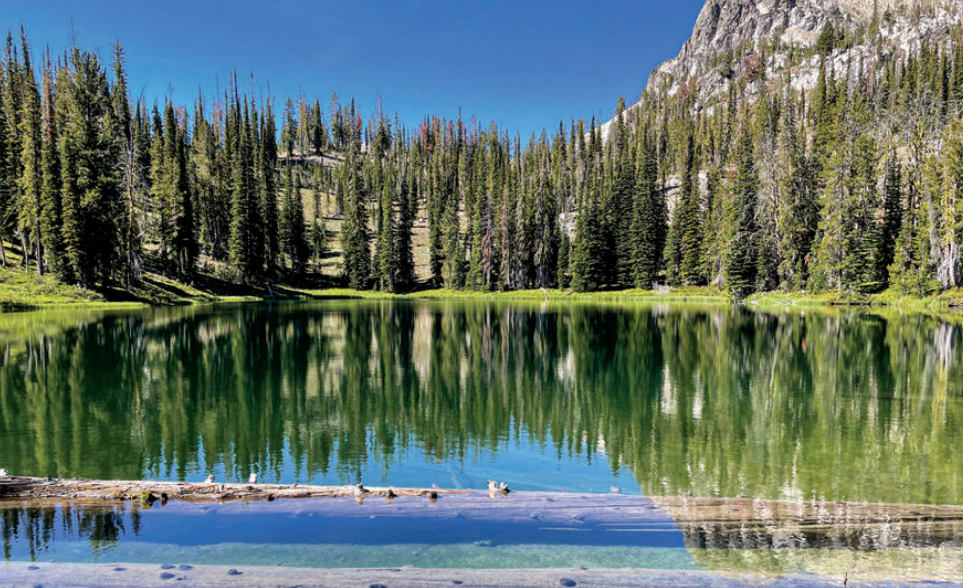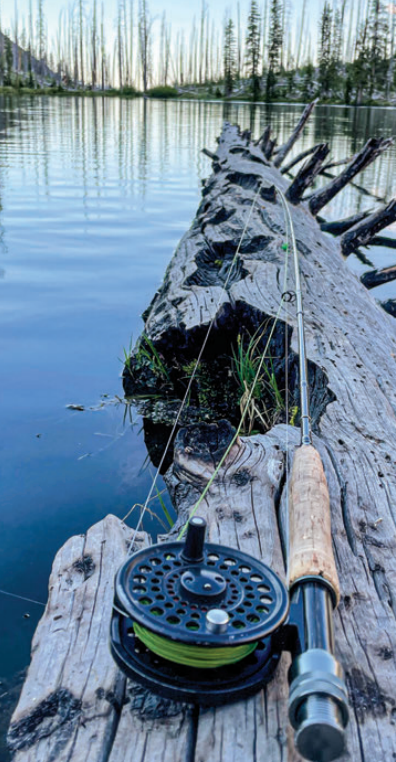
Fall for Late Alpine Trout

There’s still plenty of time to catch hungry fish at high lakes before ice-up, and here’s how.
By Matthew DwonchWhen temperatures start to drop, bugles ring out and the aspens go gold, many outdoorsy folks put down the fly rod in favor of archery equipment. There’s nothing like chasing screaming bulls through the timber, but for those who want to extend their fly fishing season an extra month or two, the high country provides plenty of opportunity. The alpine zone turns especially beautiful in September too.
Mountain lakes are typically seen as a summer specialty, but these hotspots of alpine life often remain open into midfall and beyond. Most backpacking trips require at least a few miles of foot travel, so it suits you to be well-prepared. Along with some common sense, this article should get you ready for a late-season fly fishing adventure.
WHAT TO PACK
Trip preparation should start with the most basic of human needs and progress from there. In other words, your choice of tent for an overnighter is a whole lot more important than your choice of fly rod, although a bad choice on either can cause frustration.
It is critical to have a reliable tent in the backcountry, especially during September, when inclement weather is more likely. I roll with an REI Half-Dome 2 Plus tent, which has served me well for many years. If you’re looking for something a little fancier, Kuiu has some solid offerings.
For summer applications, a 30-degree sleeping bag is almost always appropriate. However, I have seen nights in early September dip into the low teens. Even with warm clothing, sleep was scarce on these nights. For late summer and early fall, a 15-degree bag is your best bet. Nemo and Klymit make light, backpacker-friendly sleeping bags, with some varieties rated down to 0 degrees.
When it comes to finding the right pack, consider two things: durability and space. I use an Outdoorsman’s hunting pack for all my fishing backpacking trips. The extra space added for hauling meat out of the backcountry allows me to pack a wide selection of flies and tackle that would get left at home with more conventional packs. If you are looking for something without camo, Osprey, Eberlestock and Stone Glacier are all fine options.
This is by no means an exhaustive list of gear required for a late-season backpacking trip, but if you’ve made it this far, I assume you already know that. Also vital to your success is a water filter, satellite phone, mini stove, sleeping pad, pillow and plenty of freeze-dried food. But for now, let’s get to the fun of fishing.

TACKLE AND TACTICS
One of the many draws of fly fishing mountain lakes during fall is the conspicuous absence of human beings. By September, most summer backpackers are either relaxing at home or being outwitted by elk. Due to the lack of fishing pressure, fish are often aggressive and more than willing to take dry flies off the surface.
One fly almost always gets eaten without hesitation: the black ant. It’s a simple thing, but its cleverness is in its utility. Ants are hardy bugs and won’t disappear with a couple of cold nights. Fish in mountain lakes will often be fooled by a standard size 18 black ant. But if this pattern isn’t producing, ants come in many flavors up here, so it’s smart to include green and red ants in your arsenal.
Also productive on top of the water during early September are hopper patterns. Once the freeze hits, the backcountry fish are less likely to be fooled by these oversized bugs, but until then it’s always worth throwing a hopper in hopes of that irreplicable topwater strike.
Ants and hoppers aren’t exactly groundbreaking suggestions, I know, but they almost always get the job done on high-mountain lakes. Attractors are also a must-have when packing for your late-season adventure. The Royal Wulff has given me several days in the backcountry I won’t soon forget. I once bounced from lake to lake in a secluded basin, catching rainbow trout to my heart’s content on a solitary tattered Royal Wulff pattern.
As with any body of water, there is more happening under the water than above in alpine lakes. Expect dragonfly nymphs, damselfly nymphs, water boatmen, tadpoles and minnows to still be active. When it gets cooler in the fall, fish often retreat to the floor of the lake, offering a great opportunity to throw various wet patterns. My favorite is a size 10 olive-green damselfly nymph stripped slowly towards the shore. Woolly Buggers are a classic lake necessity, but be aware of the size and species of fish in your chosen water. Cutthroats are less prone to attack Buggers than other species.
When it comes to stationary wet flies, there is one fly that dominates the competition on mountain lakes. A size 16 chartreuse Copper John is certain to tempt even the snobbiest of trout into a bite. Dangled about 4 feet under the surface with a size 20 Zebra Midge dropper, it is truly a deadly fly.
Variety is key when it comes to choosing flies for a backcountry trip. Alpine lakes have limited food resources, which causes fish to focus on a single food source, depending on time of year. Make sure you are ready to adjust to these food restrictions and you will likely be successful.
Your hardware selection should follow the ongoing theme of simplicity with variety. When I started backpacking into mountain lakes, I bought a 5-weight Fenwick Nighthawk four-piece rod. The rod has been dependable, durable and perfect for backpacking. It’s almost imperative to invest in a four-piece rod before you start backpacking into the alpine. Two-piece rods are clunky and always find a way to break outside of their cases on long hiking excursions. A 4-weight rod may be more appropriate for some lakes, but I’ve seen enough big fish in mountain lakes to stick with the 5-weight.
For most applications, 5x leaders and tippet are sufficient. If truly giant fish are cruising, I will sometimes switch to 4x, while especially shy fish will see 6x thrown their way. For those who don’t mind adding a little extra weight to their packs, bringing along a spare reel with a sinking-tip line is a great idea. A sink tip allows you to throw Woolly Buggers and leech patterns into deeper holes, hopefully coaxing out larger fish.
LOCATION
A lot goes into choosing the location of an alpine lake adventure. It’s difficult to get an exact idea of what you’re getting into if you’ve never been to the lake, but there are a few ways to choose wisely. First, narrow your search to a handful of locations. Then, study each on Google Earth. Look for lakes with plenty of surrounding vegetation, whether that be trees or shrubs. These lakes support more life than sparsely vegetated waters, and thus almost always grow bigger fish. Finally, look for lakes with a deep blue hue rather than a greenish or light blue coloration. Dark blue lakes are deeper and therefore won’t freeze solid in winter.
Idaho, Oregon and Washington all have online stocking records for high lakes. State officials typically stock fish in mountain waters once every three years. If you are looking for big fish, plan on waiting until the third year after stocking to visit.
HIT THE TRAIL!
Whether it’s your first time backpacking in to fly fish or your thousandth, know that the alpine late season will provide you with plenty of wonderful opportunities at cutthroat, rainbows, brook and even the rare golden trout. While bowhunting is certainly a worthy pursuit, mountain trout can be an excellent September escape. NS
